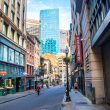Miami’s investment in downtown culture lures private sector growth
By Marc Sarnoff
The Art Basel show in Miami Beach has come and gone, but the economic impact of arts and culture in Miami stretches far beyond December. While art fairs held across the city reported record levels of attendance and sales in 2013, the real takeaway from Miami Art Week was how the center of gravity in Miami’s cultural and entertainment landscape is gradually shifting to the mainland.
Long considered an afterthought by comparison with the sand and surf of Miami Beach, downtown Miami is now viewed as a cultural and lifestyle destination in its own right. This realignment has not been accidental; Miami’s public sector has made a conscious effort to invest meaningful dollars in the creation of a vibrant urban core home to a healthy mix of residential, commercial and civic uses supported by a robust cultural infrastructure.
Museum Park, home to the new Pérez Art Museum Miami and under-development Patricia and Phillip Frost Museum of Science, is rising as a new anchor for downtown. The Adrienne Arsht Center for the Performing Arts, one block north, continues to attract close to 500,000 patrons annually. The Wynwood Arts District and the nearby Design District are earning recognition among the country’s most creative, fashion-forward and urban neighborhoods.
If the state legislature makes Florida a tax free art zone (Rhode Island recently passed similar legislation), Florida will become an international hub for art transactions and more positive economic impact will follow.
Major investments in culture are already underway. New galleries, performance spaces and artist studios are opening in the Central Business District. And art initiatives like Downtown Art Days in September are luring locals and out-of-town visitors who patronize area shops and restaurants.
Miami’s public and private sectors have invested hundreds of millions of dollars in the creation of a viable arts and entertainment infrastructure in downtown and the surrounding neighborhoods. Our community is benefitting in the form of soaring population growth, the arrival of new companies, direct economic impact and a level of inbound investment never before seen in our urban core.
Today there are more than three dozen cranes dotting the Miami skyline – the second most in the U.S., behind only San Francisco. More than 20 additional projects are currently in the planning phase.
Miami’s urban core is now viewed as a cultural, lifestyle and entertainment destination for the first time in our city’s history.
The real-world economic benefit of this activity is significant. An Americans for the Arts study determined that the economic impact of arts and culture in Miami has eclipsed $1 billion for the first time, with much of this spending taking place in downtown.
This impact is projected to grow over the coming years as some of the largest and most credible developers from around the world acquire land and break ground on major real estate projects in close proximity to our cultural venues.
Mixed-use projects already in developmen will breathe new life into downtown Miami’s streets over the coming years and serve as a magnet for further investment.
There is already evidence that more progress is forthcoming, spurred by capital investments in downtown streetscape improvements, new public transit options, an influx of tens of thousands of new residents, and the creation of a world-class waterfront park adjacent to the art and science museums.
Miami is helping to fuel additional growth by creating a pedestrian priority zone in downtown which will ensure area streets are walkable and safe. The zone will entail well-marketed crosswalks, consistent street-lighting, coordinated stop lights, and ramps aligned with sidewalks. Other features will include speed limits reduced to 25 miles per hour and sidewalks that are a minimum of six feet wide.
With smart growth and collaboration between the public and private sectors, Miami is thriving.
Marc Sarnoff is chairman of the Miami City Commission, representing District 2, and chairman of the Miami Downtown Development Authority.
_____________
To get connected and stay up-to-date with similar content from American City & County:
Like us on Facebook
Follow us on Twitter
Watch us on Youtube




















